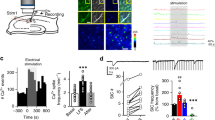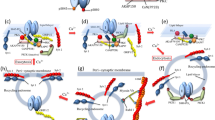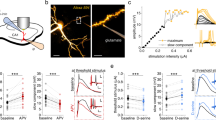Abstract
At glutamatergic synapses, calcium influx through NMDA receptors (NMDARs) is required for long-term potentiation (LTP); this is a proposed cellular mechanism underlying memory and learning. Here we show that in lateral amygdala pyramidal neurons, SK channels are also activated by calcium influx through synaptically activated NMDARs, resulting in depression of the synaptic potential. Thus, blockade of SK channels by apamin potentiates fast glutamatergic synaptic potentials. This potentiation is blocked by the NMDAR antagonist AP5 (D(-)-2-amino-5-phosphono-valeric acid) or by buffering cytosolic calcium with BAPTA. Blockade of SK channels greatly enhances LTP of cortical inputs to lateral amygdala pyramidal neurons. These results show that NMDARs and SK channels are colocalized at glutamatergic synapses in the lateral amygdala. Calcium influx through NMDARs activates SK channels and shunts the resultant excitatory postsynaptic potential. These results demonstrate a new role for SK channels as postsynaptic regulators of synaptic efficacy.
This is a preview of subscription content, access via your institution
Access options
Subscribe to this journal
Receive 12 print issues and online access
$209.00 per year
only $17.42 per issue
Buy this article
- Purchase on Springer Link
- Instant access to full article PDF
Prices may be subject to local taxes which are calculated during checkout






Similar content being viewed by others
References
Sabatini, B.L., Oertner, T.G. & Svoboda, K. The life cycle of Ca2+ ions in dendritic spines. Neuron 33, 439–452 (2002).
Johnston, D. et al. Active dendrites, potassium channels and synaptic plasticity. Phil. Trans. R. Soc. Lond. B 358, 667–674 (2003).
Tsay, D. & Yuste, R. On the electrical function of dendritic spines. Trends Neurosci. 27, 77–83 (2004).
Sah, P. & Faber, E.S.L. Channels underlying neuronal calcium-activated potassium currents. Prog. Neurobiol. 66, 345–353 (2002).
Stocker, M. & Pedarzani, P. Differential distributions of three Ca2+-activated K+ channel subunits, SK1, Sk2 and SK3 in the adult rat central nervous system. Mol. Cell. Neurosci. 15, 476–493 (2000).
Sailer, C.A. et al. Regional differences in distribution and functional expression of small-conductance Ca2+-activated K+ channels in rat brain. J. Neurosci. 22, 9698–9707 (2002).
Romey, G., Hugues, M., Schmid-Antomarchi, H. & Lazdunski, M. Apamin: a specific toxin to study a class of Ca2+-dependent K+ channels. J. Physiol. (Paris) 79, 259–264 (1984).
Castle, N.A., Haylett, D.G. & Jenkinson, D.H. Toxins in the characterization of potassium channels. Trends Neurosci. 12, 59–65 (1989).
Villalobos, C., Shakkottai, V.G., Chandy, K.G., Michelhaugh, S.K. & Andrade, R. SKCa channels mediate the medium but not the slow calcium-activated afterhyperpolarization in cortical neurons. J. Neurosci. 24, 3537–3542 (2004).
Stocker, M., Krause, M. & Pedarzani, P. An apamin-sensitive Ca2+-activated K+ current in hippocampal pyramidal neurons. Proc. Natl. Acad. Sci. USA 96, 4662–4667 (1999).
Pedarzani, P. et al. Control of electrical activity in central neurons by modulating the gating of small conductance Ca2+-activated K+ channels. J. Biol. Chem. 276, 9762–9769 (2001).
Faber, E.S.L. & Sah, P. Physiological role of calcium-activated potassium currents in the rat lateral amygdala. J. Neurosci. 22, 1618–1628 (2002).
Sah, P. & Bekkers, J.M. Apical dendritic location of slow-afterhyperpolarization current in hippocampal pyramidal neurons: implications for the integration of LTP. J. Neurosci. 16, 4537–4542 (1996).
Cai, X. et al. Unique roles of SK and Kv4.2 potassium channels in dendritic integration. Neuron 44, 351–364 (2004).
Cangiano, L., Wallen, P. & Grillner, S. Role of apamin-sensitive k(ca) channels for reticulospinal synaptic transmission to motoneuron and for the afterhyperpolarization. J. Neurophysiol. 88, 289–299 (2002).
Yamada, S., Takechi, H., Kanchiku, I., Kita, T. & Kato, N. Small-conductance Ca2+-dependent K+ channels are the target of spike-induced Ca2+ release in a feedback regulation of pyramidal cell excitability. J. Neurophysiol. 91, 2322–2329 (2004).
Fiorillo, C.D. & Williams, J.T. Glutamate mediates an inhibitory postsynaptic potential in dopamine neurons. Nature 394, 78–82 (1998).
Grillner, S., Wallen, P., Hill, R., Cangiano, L. & El Manira, A. Ion channels of importance for the locomotor pattern generation in the lamprey brainstem-spinal cord. J. Physiol. (Lond.) 533, 23–30 (2001).
Behnisch, T. & Reymann, K.G. Inhibition of apamin-sensitive calcium dependent potassium channels facilitate the induction of long-term potentiation in the CA1 region of rat hippocampus in vitro. Neurosci. Lett. 253, 91–94 (1998).
Stackman, R.W. et al. Small conductance Ca2+-activated k+ channels modulate synaptic plasticity and memory encoding. J. Neurosci. 22, 10163–10171 (2002).
Faber, E.S.L., Callister, R.J. & Sah, P. Morphological and electrophysiological properties of principal neurons in the rat lateral amygdala in vitro. J. Neurophysiol. 85, 714–723 (2001).
Mahanty, N.K. & Sah, P. Excitatory synaptic inputs to pyramidal neurons of the lateral amygdala. Eur. J. Neurosci. 11, 1217–1222 (1999).
Weisskopf, M.G. & LeDoux, J.E. Distinct populations of NMDA receptors at subcortical and cortical inputs to principal cells of the lateral amygdala. J. Neurophysiol. 81, 930–934 (1999).
Nowak, L., Bregestovski, P., Ascher, P., Herbet, A. & Prochiantz, A. Magnesium gates glutamate-activated channels in mouse central neurones. Nature 307, 462–465 (1984).
Hirschberg, B., Maylie, J., Adelman, J.P. & Marrion, N.V. Gating of recombinant small-conductance Ca-activated K+ channels by calcium. J. Gen. Physiol. 111, 565–581 (1998).
MacDermott, A.B., Mayer, M.L., Westbrook, G.L., Smith, S.J. & Barker, J.L. NMDA-receptor activation increases cytoplasmic calcium concentration in cultured spinal cord neurones. Nature 321, 519–522 (1986).
Roncarati, R., Di Chio, M., Sava, A., Terstappen, G.C. & Fumagalli, G. Presynaptic localization of the small conductance calcium-activated potassium channel SK3 at the neuromuscular junction. Neuroscience 104, 253–262 (2001).
Obermair, G.J., Kaufmann, W.A., Knaus, H.G. & Flucher, B.E. The small conductance Ca2+-activated K+ channel SK3 is localized in nerve terminals of excitatory synapses of cultured mouse hippocampal neurons. Eur. J. Neurosci. 17, 721–731 (2003).
Zucker, R.S. Short term synaptic plasticity. Annu. Rev. Neurosci. 12, 13–31 (1989).
Neher, E. in Calcium Electrogenesis and Neuronal Functioning (eds. Heinemann, U., Klee, U., Neher, E. & Singer, W.) 80–96 (Springer, Berlin, 1986).
Power, J.M. & Sah, P. Nuclear calcium signaling evoked by cholinergic stimulation in hippocampal CA1 pyramidal neurons. J. Neurosci. 22, 3454–3462 (2002).
Weisskopf, M.G., Bauer, E.P. & LeDoux, J.E. L-type voltage-gated calcium channels mediate NMDA-independent associative long-term potentiation at thalamic input synapses to the amygdala. J. Neurosci. 19, 10512–10519 (1999).
Huang, Y.Y. & Kandel, E.R. Postsynaptic induction and PKA-dependent expression of LTP in the lateral amygdala. Neuron 21, 169–178 (1998).
Shah, M.M. & Haylett, D.G. K+ currents generated by NMDA receptor activation in rat hippocampal pyramidal neurons. J. Neurophysiol. 87, 2983–2989 (2002).
Wei, D.S. et al. Compartmentalized and binary behavior of terminal dendrites in hippocampal pyramidal neurons. Science 293, 2272–2275 (2001).
Yuste, R. & Denk, W. Dendritic spines as basic functional units of neuronal integration. Nature 375, 682–684 (1995).
Kovalchuk, Y., Eilers, J., Lisman, J. & Konnerth, A. NMDA receptor-mediated subthreshold Ca2+ signals in spines of hippocampal neurons. J. Neurosci. 20, 1791–1799 (2000).
Xia, X-M. et al. Mechanism of calcium gating in small-conductance calcium-activated potassium channels. Nature 395, 503–507 (1998).
Humeau, Y. et al. Dendritic spine heterogeneity determines afferent-specific Hebbian plasticity in the amygdala. Neuron 45, 119–131 (2005).
Glowatzki, E. & Fuchs, P.A. Cholinergic synaptic inhibition of inner hair cells in the neonatal mammalian cochlea. Science 288, 2366–2368 (2000).
Oliver, D. et al. Gating of Ca2+-activated K+ channels controls fast inhibitory synaptic transmission at auditory outer hair cells. Neuron 26, 595–601 (2000).
Belcadi-Abbassi, W. & Destrade, C. Post-test apamin injection suppresses a Kamin-like effect following a learning session in mice. Neuroreport 6, 1293–1296 (1995).
Ikonen, S. & Riekkinen, P., Jr. Effects of apamin on memory processing of hippocampal-lesioned mice. Eur. J. Pharmacol. 382, 151–156 (1999).
Ikonen, S., Schmidt, B. & Riekkinen, P., Jr. Apamin improves spatial navigation in medial septal-lesioned mice. Eur. J. Pharmacol. 347, 13–21 (1998).
van der Staay, F.J., Fanelli, R.J., Blokland, A. & Schmidt, B.H. Behavioral effects of apamin, a selective inhibitor of the SK(Ca)-channel, in mice and rats. Neurosci. Biobehav. Rev. 23, 1087–1110 (1999).
Acknowledgements
This work was supported by grants from the National Heath and Medical Research Council of Australia and the Australian Research Council.
Author information
Authors and Affiliations
Corresponding author
Ethics declarations
Competing interests
The authors declare no competing financial interests.
Rights and permissions
About this article
Cite this article
Faber, E., Delaney, A. & Sah, P. SK channels regulate excitatory synaptic transmission and plasticity in the lateral amygdala. Nat Neurosci 8, 635–641 (2005). https://doi.org/10.1038/nn1450
Received:
Accepted:
Published:
Issue Date:
DOI: https://doi.org/10.1038/nn1450
This article is cited by
-
Functional and phosphoproteomic analysis of β-adrenergic receptor signaling at excitatory synapses in the CA1 region of the ventral hippocampus
Scientific Reports (2023)
-
Presynaptic NMDARs on spinal nociceptor terminals state-dependently modulate synaptic transmission and pain
Nature Communications (2022)
-
PKA and Ube3a regulate SK2 channel trafficking to promote synaptic plasticity in hippocampus: Implications for Angelman Syndrome
Scientific Reports (2020)
-
Enhanced ventral hippocampal synaptic transmission and impaired synaptic plasticity in a rodent model of alcohol addiction vulnerability
Scientific Reports (2017)
-
Sensitization of Ion Channels Contributes to Central and Peripheral Dysfunction in Neurofibromatosis Type 1
Molecular Neurobiology (2017)



